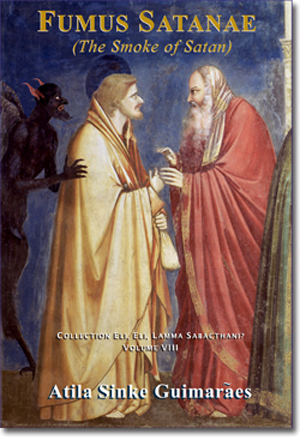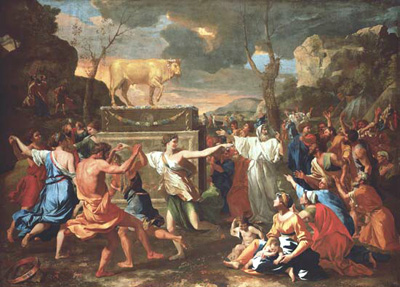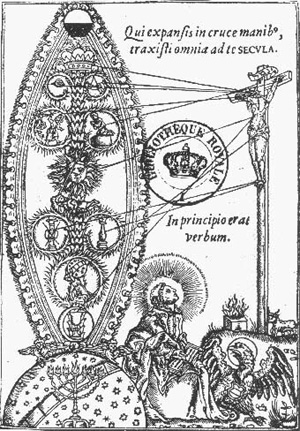Book Reviews
 |
 |
 |
 |
 |
 |
 |
How the Vice of the Jews Influences
New Theology
Book-review of Fumus Satanae (The Smoke of Satan) by Atila Sinke Guimarães, Volume 8 of the Collection Eli, Eli, Lamma Sabacthani?, TIA: Los Angeles, 2015, 398 pp.

Purchase here
In his latest book Fumus Satanae, Atila Sinke Guimarães applies what he learned on this topic from his mentor Prof. Plinio to examine the capital vice of the Jewish people. Then he masterfully shows how this vice contributed to the birth of the Kabbalah (Chap. 7 § 21). It is a brilliant analysis and a fascinating study for anyone interested in the psychology of peoples, as well as in the underlying cause of the infidelity of the Jewish people. This vice also has a direct relationship to the present day change of doctrine in the Conciliar Church, as Guimarães also demonstrates.
The principal vice of the Jews
Based on numerous episodes from the Old Testament, Guimarães shows that the principal vice of the Jews is their human respect before others and their fear to manifest the true Faith. This was, in fact, their vocation, to preserve and faithfully guard the true Faith as a people apart, a Chosen People. From their succumbing to human respect came the consequence of their servile imitation of the pagans they were called to convert.
Time and time again in History we find the Jews abandoning the Faith and turning to pagan ceremonies because of their lack of confidence in the Lord. I note several of the many instances Guimarães cites:

Immitating the Egyptians the Jews adored a golden calf
- After being freed from the Egyptian captivity, the people made a golden calf inspired by the cult to the Egyptian god Apis;
- During their time of wandering in the Sinai before reaching the Promised Land, they imitated the Moabites by adoring their gods;
- During the Babylon captivity they imitated first the Assyrians and Chaldeans, and then the Persians, their liberators;
- They also imitated the Greeks with the general Hellenization introduced in Judea in the time of the Selleucids, and the Romans with the reform carried out by Herod the Great in the whole Kingdom of Judea and principally in the Temple.
The key to the Kabbalah
It is this vice of servile imitation of other peoples that Guimarães points to as the key to understand the formation of the Jewish Kabbalah.
To formulate the Kabbalah, Jewish scholars and rabbis turned to the old Gnostic sects to borrow and imitate their tenets. Guimaràes quotes noted contemporary authors who affirm this link of Gnosis with the Kabbalah, to the point that the latter was sometimes actually called "the Jewish Gnosis" (Chap 7, § 21).
Why is this connection important for the purposes of his study? Guimarães points out two reasons:
"The first is that the men who explicate and accept such doctrine would fight against the one true Faith, in which intolerance toward any form of error or evil is a presupposition.
"The second is that they would try to break this exclusivity and intolerance so that the true Faith would become relative and could also be included in their amalgam."
The first fight, Guimarães explains, is carried out occultly and is the secret conspiracy directed by the Jews against the Catholic Faith. To support that statement he provides a psychological analysis of vice and virtue and the historical evidence from Scriptures to prove such a conspiracy of evil men who have caballed against God and His followers from the beginning of the world.
What Guimarães aims to prove – and does so convincingly – is that "the Kabbalah is a conspiracy made against God and the truth, and, therefore, against the just in the Old Testament and against Our Lord Jesus Christ and the Holy Catholic Church in the New Testament." I invite the reader to pursue his arguments more deeply in Chapter 7, §§ 27-36.
The second fight – to destroy the intolerance of the good toward any form of error or evil in order to assimilate them into the errors of the Jewish capital vice – is carried out openly. The aim is to make all others – and especially Catholics – fall into the same syncretism that the Jews wrongly adopted following their capital vice (Chapter 7, §§ 38-48).

A blend of Catholicism & the Kabbalah was introduced in the Renaisance; today it returns with Progressivism
The strategy is the same one that has been applied for centuries, only now the syncretism is being made by the Catholic theologians, who have borrowed from Jewish and Gnostic teachings in order to change the very nature of the Trinity itself. Guimarães demonstrates this showing how the documents of the Kabbalah and Gnosis are deeply akin with the thinking of today's progressivists.
Here are some of the many affinities between the teachings of Progressivism, early Gnosis and Kaballah:
- A self-divestment and suffering in God that comes as a consequence of a fall;
- The existence of an Eternal Feminine installed in the Divinity and a consequent divine androgynism;
- The presentation of the Creator as an implacable Judge who does not understand mercy and love, brought only later by Christ;
- The presentation of Creation as a defective process;
- The acceptance of Creation as an emanation of the divine principle and, thus, a divine immanence in all beings;
- The superiority of the feminine element that demands the feminization of men in the Church;
- An androgynous first man that is the ideal of humanity;
- The supposition of an intermediary sphere between God and Creation;
- The admission of an eternal sin committed in this sphere (for the progressivists, it is the mysterious adultery of the Eternal Church that demands the crucifixion of Christ);
- A war of the gods, where the Father plots the Son's death on the Cross;
- A final pardon of the Devil who will be admitted into Heaven at the side of God, just as for the gnostics the demiurge will be integrated into the divine pleroma at the end of History.

Posted July 10, 2015
______________________
______________________



